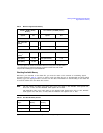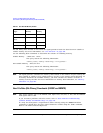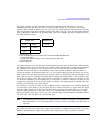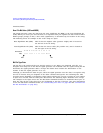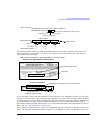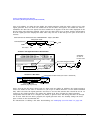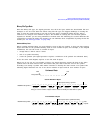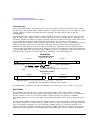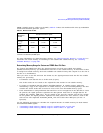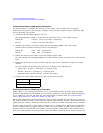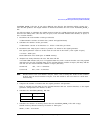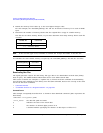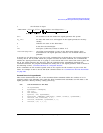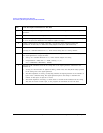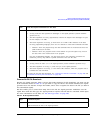
292 Agilent N518xA, E8663B, E44x8C, and E82x7D Signal Generators Programming Guide
Creating and Downloading User-Data Files
User File Data (Bit/Binary) Downloads (E4438C and E8267D)
Framed Binary Data
When using framed data, ensure that you use an even number of bytes and that the bytes contain
enough bits to fill the data fields within a timeslot or frame. When there are not enough bits to fill
a single timeslot or frame, the signal generator replicates the data pattern until it fills the
timeslot/frame.
The signal generator creates successive timeslots/frames when the user file contains more bits than
what it takes to fill a single timeslot or frame. When there are not enough bits to completely fill
successive timeslots or frames, the signal generator truncates the data at the bit location where there
is not enough bits remaining and repeats the data pattern. This results in a data pattern
discontinuity. For example, a frame structure that uses 348 data bits requires a minimum file size of
44 bytes (352 bits), but uses only 43.5 bytes (348 bits). In this situation, the signal generator
truncates the data from bit 3 to bit 0 (bits in the last byte). Remember that the signal generator
views the data from MSB to LSB. For this example to have an even number of bytes and enough bits
to fill the data fields, the file needs 87 bytes (696 bits). This is enough data to fill two frames while
maintaining the integrity of the data pattern, as illustrated in the following figure.
For information on editing a file after downloading, see “Modifying User File Data” on page 302.
User File Size
You download user files into non-volatile memory. For CDMA, GPS, and W-CDMA, the signal
generator accesses the data directly from non-volatile memory, so the file size up to the maximum
file size (shown in Table 8-2) for these formats is limited only by the amount of available
non-volatile memory. As seen in the table, the baseband generator option does not affect these file
sizes.
For Custom and TDMA, however, when the signal generator creates the signal, it loads the data from
non-volatile memory into volatile memory, which is also the same memory that the signal generator
uses for Arb-based waveforms. For user data files, volatile memory is commonly referred to as
pattern ram memory (PRAM). Because the Custom and TDMA user files use volatile memory, their
maximum file size depends on the baseband generator (BBG) option and the amount of available
348 data bits
Ctrl
Ctrl
110100110110...01101111352 bits (44 bytes):
Truncated data (bits 0–3)
not enough bits remaining to fill the next frame
348 data bits
Ctrl
Ctrl
348 data bits
Ctrl
Ctrl
011101100110110101110100110110...01101111696 bits (87 bytes):
348 data bits
Ctrl
Ctrl
Frame 1
Frame 2
Frame 1 data repeated
Frame 1
Frame 2
Even Number of Bytes
Uneven Number of Bytes
(some data truncated)
(all bits used)
Data fills both frames (348 bits per frame) with no truncated bits
Frame 1 data
Framed Data
MSB
LSB




